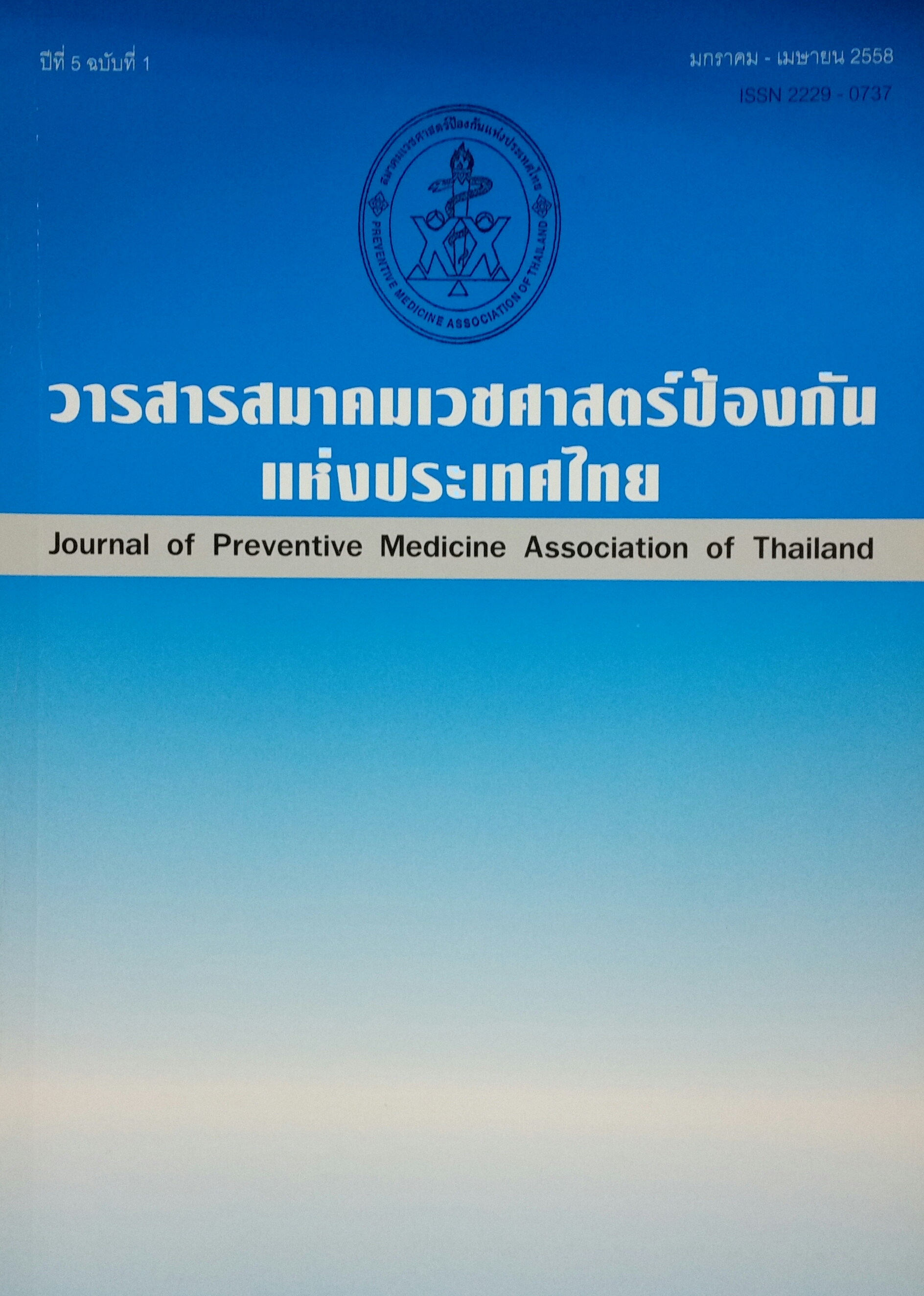The Results of Multidisciplinary Care on the Rehabilitation of the Hemorrhagic Stroke Patients at the Male Surgery Ward, Phra Nakhon Si Ayutthaya Hospital
Keywords:
Multidisciplinary Care, Hemorrhagic stroke patientsAbstract
This descriptive research’s objective is to study the results of the multidisciplinary care on the rehabilitation of the hemorrhagic stroke patients. The sampling populations were the hemorrhagic stroke patients at the Male Surgery Ward, Phra Nakhon Si Ayutthaya Hospital. The data had been collected from October, 2013 to March, 2014. The sampling technique applied was purposive sampling. The researching instruments were questionnaire on personal information and Barthel ADL Index for the Activities of Daily Living Assessment/(ADL), which assesses the ability of doing daily routine of the patients. Furthermore, assessing of the ADL was applied in 4 phases as pre-research, before discharge, 4 and 12 weeks after discharge. The collected data, then, was analyzed by statistical software, using descriptive statistics technique. t-test statistics was applied in comparing the results of the hemorrhagic patients, before and after the care. By the result, it was found out that, among the 30 sampling populations, between 29 - 93 years of age (= 56.27, SD = 6.127), 16 were underlying hypertension disease and 7 of them had inappropriate healthcare behavior. The initial Glasgow Coma Scale (GCS) was between 5 - 15 (
= 12.93, SD = 3.140). Lt. basal ganglia hemorrhage was found for 30.00%. Most of the patients had been treated by using supportive treatment. GCS level and LOS before discharge was between 13 - 15 (
= 12.93, SD = 3.140), and 2 - 22 days (
= 12.93, SD = 3.140) respectively. Initial ADL scores were between 0 - 20 (
= 18.17, SD = 16.942 ; 10 - 85 (
= 18.17, SD = 16.942) before discharge, 15 - 100 (
= 68.83, SD = 2.455) and 20 - 100 (
= 85.17, SD = 2.219) after discharge 4 and 12 weeks respectively. The result of comparing the scores of the patients doing daily activities, between initial admission - before discharge, and before discharge - 4 weeks after discharge and 4 weeks after discharge - 12 weeks after discharge, was that the two phases are significantly different at the level of .05.
The result of this research could be applied in developing the system for treating the hemorrhagic stroke patients for better quality. The development could support the patients to get inclusive and complete care. They could well rehabilitate. The chances of the disease’s complication could be lessened and prevented. Moreover, the result of this research could be applied in creating activities to enhance knowledge and skills for the relatives who care for the hemorrhagic stroke patients admitted at the hospital, so that the continual care for the patients could be more effective.
References
2. สงวน นิตยารัมภ์พงศ์. ทั่วโลกตายด้วยโรคหลอดเลือดสมองนาทีละ 11 ราย. 2549. (วันที่ค้นข้อมูล 12 กุมภาพันธ์ 2557). แหล่งข้อมูล https://www. bangkokhealth. com/healthnews htdoc/healthnews detail. asp? Number=14830. ผู้จัดการออนไลน์.
3. เพ็ญแข แดงสวรรณ. Stroke ฆาตกรเงียบ. พิมพ์ครั้งที่ 2. กรุงเทพฯ: ก.พล (1999).2550.
4. สถิติสำนักนโยบายและยุทธศาสตร์. สรุปสถิติที่สำคัญ พ.ศ. 2556. (วันที่ค้นข้อมูล 1 ตุลาคม 2557). แหล่งข้อมูล : https://www.msociety.go.th/article_attach/11378/15693.pdf.
5. งานเวชสถิติโรงพยาบาลพระนครศรีอยุธยา. รายงานสถิติประจำปี 2555. พระนครศรีอยุธยา : โรงพยาบาลพระนครศรีอยุธยา. 2556.
6. เยาวลักษณ์ หาญวชิรวงศ์, ไพรวัลย์ พรมที, ทินวิสุทธิ์ ศรีละมัย และสุวรรณา ธาดาพิพฒน์. การพัฒนาแผนการดูแลผู้ป่วยโรคหลอดเลือดสมองโดยการมีส่วนร่วมของสหสาขาวิชาชีพ โรงพยาบาลขอนแก่น. วารสารขอนแก่น. 2549;30(3):272-283.
7. Johnston KC, Connors AF, Jr, Wagner DP, Haley EC, Jr. Predicting outcome in ischemic stroke: external validation of predictive risk models. Stroke. 2003;Jan;34(1):200-2.
8. สถาบันประสาทวิทยา. แนวทางการพยาบาลผู้ป่วยโรคหลอดเลือดสมองสำหรับพยาบาลทั่วไป. นนทบุรี : กรมการแพทย์ กระทรวงสาธารณสุข. 2550.
9. Burns, N., & Grove, SK. The Practice of Nursing Research Conduct, Critique, and Utilization. (5nded.) Philadelphia: Elsevier saunders. 2005.
10. เกสร อิ่มสุข. ผลของการพัฒนารูปแบบการดูแลผู้ป่วยโรคหลอดเลือดสมอง แบบสหสาขาวิชาชีพ โรงพยาบาลเจ้าพระยาอภัยภูเบศร์. วารสารสมาคมพยาบาลฯ สาขาภาคตะวันออกเฉียงเหนือ. 2554;29(3);15-24.
11. นิ่มนวล ชูยิ่งสกุลทิพย์. ผลของการจำหน่ายแบบสหสาขาวิชาชีพต่อความสามารถในการทำกิจกรรมของผู้ป่วยโรคหลอดเลือดสมองในโรงพยาบาลระยอง. วารสารคณะพยาบาลศาสตร์ มหาวิทยาลัยบูรพา 2550;15(4);.50-62.
12. ประกอบพร ทิมทอง. ภาวนา กีรติยุตวงศ์, รัชนี สรรเสริญ. ปัจจัยที่มีความสัมพันธ์กับความสามารถของผู้ดูแลผู้ป่วยโรคหลอดเลือดสมอง. วารสารคณะพยาบาลศาสตร์ มหาวิทยาลัยบูรพา 2551;16(1);9-21.
Downloads
Published
How to Cite
Issue
Section
License
บทความที่ลงพิมพ์ในวารสารเวชศาสตร์ป้องกันแห่งประเทศไทย ถือเป็นผลงานวิชาการ งานวิจัย วิเคราะห์ วิจารณ์ เป็นความเห็นส่วนตัวของผู้นิพนธ์ กองบรรณาธิการไม่จำเป็นต้องเห็นด้วยเสมอไปและผู้นิพนธ์จะต้องรับผิดชอบต่อบทความของตนเอง






